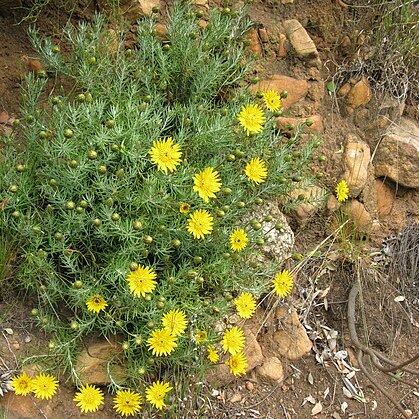Habit: compact, sparsely-to well-branched shrublet forming a low, broad bush, to about 1.2 m (but usually 0.30-0.70 m) high. Stems: young stems soft, herbaceous, longitudinally striate, white-tomentose but not glandular; white-woolly tomentum of young stems continuous onto leaf buds and abaxial surfaces of mature leaves. Older stems woody, to about 1.0 cm in diameter, leafless, with smooth greyish-brown bark marked with leaf-scars. Leaves: densely or sparsely arranged around stem at branch ends, imbricate, erect, linear-lanceolate, 15-50 x 1.5-3.0 mm, ± equal in length along stem, sessile, not narrowing towards base, apically acute with a small mucro, leaf lamina somewhat thickened and leathery; margins strongly revolute, folded back over the abaxial surface which is thus largely obscured except for a small central portion, margins entire or with small, widely-spaced, acute mucro-like teeth; leaf adaxial surface dark green, glabrescent with slightly indented midvein; abaxial surface densely white-tomentose with midvein thickened, prominent, green and glabrescent in contrast to the white-tomentose abaxial leaf surface. Peduncle: 10-40 mm or rarely up to 70 mm long, increasing in length at floral maturity, sometimes bearing one or two small leaflike bracteoles; reddish-brown, faintly striate, not woolly or only sparsely so, and bearing a covering of trichomes (type A) that is most densely spaced at top of the peduncle. Capitula: radiate, 40-70 mm in diameter including the expanded rays; containing ± 75-85 disc florets and (12-)20-30 rays. Old heads not retained on plant. involucre: 10-25 mm across, fleshy portions of bracts densely glandular with trichome type A, or glabrous or sparsely white-woolly. Outer bracts narrowly deltoid-lanceolate, free portion 9 x 1.5-2.5 mm, inner bracts longer and wider, free portion 15-20 x 3-7 mm. All bracts becoming dark brown with age. Receptacle: alveole margins with shallow, irregular projections <1 mm long. Ray florets: golden yellow, tube sparsely covered with slender trichomes (type B), lamina 3-4 x 8-12 mm, ± glabrous; style apex thickened below the bifurcation but without a tuft of longer sweeping-hairs. Style branch apices rounded. Staminodes white, thin, basally with short, rounded tails, apically rounded, filaments present. Pappus and cypsela as in disc florets. Disc florets: golden yellow, 10 mm long, tube sparsely hairy with slender, multicellular hairs (trichome type B), corolla lobes broadly acute, 2-3 mm in length, slightly recurved at maturity, bearing glandular hairs (trichome type C) on abaxial surfaces. Style much-exserted, extending ± 6 mm beyond corolla tube, with a slight, abrupt thickening below the bifurcation, papillae slightly larger on thickening. Style branches ± 1 mm long, apically rounded. Anther tails extending ± 1 mm below the point of filament attachment, obliquely truncate. Apical anther appendages short, rounded, thin and flat. Cypsela: hair-covering straw-coloured or reddish-brown. Pappus: inner pappus series about the same length as the corolla, outer series about half this length, all the individual pappus elements possessing a thickened main shaft, frequently tinged blue-black towards tip. Recorded in flower mostly between October and February, with peak flowering in November, December and January. Most of the specimens flowering in other months come from localities growing very close to the sea in the Hangklip-Betty's Bay region of the south-western Cape.
More
Sprawling, closely leafy, cobwebby shrublet to 30 cm, with woody rootstock. Leaves linear, margins slightly revolute, sparsely toothed, densely woolly below, (10-)15-30 mm long. Flower heads radiate, large, solitary on short, roughly hairy peduncles, yellow.

